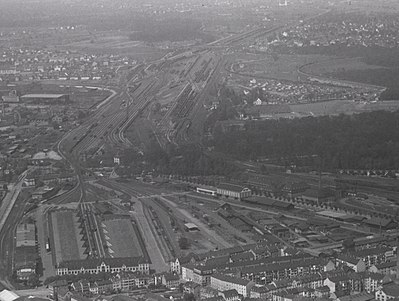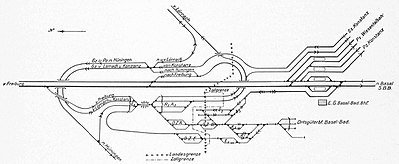Freight station Basel Bad Bf

The freight yard Basel Bad Bf ( Basel Bad Gbf ) was a freight yard in Basel, Switzerland . It opened in 1905. Since closing in the years 1998 to 2003 built on the site at present the new city district Erlenmatt in Kleinbasel .
The former, representative administration building is a listed building and houses a school.
history
In the course of the relocation and the new construction of the Badischer Bahnhof in Basel , the most expensive and extensive station of the Grand Ducal Baden State Railways was built with an investment volume of 53.1 million Reichsmarks . The new Badischer Bahnhof was opened on September 13, 1913.
The freight yard was built north of the old Baden railway station in 1855 and was able to use some of its tracks and bridges. It was opened as the first station of the major project on December 15, 1905.
In 1909, the Baden State Railways presented the Swiss authorities with plans for a four kilometer long and 200 meter wide marshalling yard between the Wiese and Haltingen . The marshalling yard Basel Bad Bf (Basel Bad RBF) was one third of Swiss territory. In the contracts that had to be concluded between Germany and Switzerland, this station was referred to as the Basel Badischer shunting station.
In 1913, the railway station area of the three Baden railway stations in Basel and Weil, with a total of 235 hectares, was shared by Switzerland with 98 hectares and the state of Baden with 137 hectares in the communities of Haltingen and Weil am Rhein . A total of 191 kilometers of track and 835 points were laid for the construction, and 652,000 cubic meters of rubble, gravel and sand were removed from the gravel terraces and transported to the lower-lying area near Basel. To realize the facilities, 17 railway bridges, five road bridges and several tunnels had to be built.
In addition, a depot with a locomotive shed for 32 locomotives and corresponding workshops was built in Haltingen. Housing estates for employees of the railway, their relatives and pensioners were built in Weil. Many moved from Basel to Weil. Another railroad workers' settlement was built in Haltingen, the area Im Rad , which is surrounded by a loop and forms a circle when viewed from the air. At times, up to 10,000 people lived at the Basel-Weil railway junction.
description
The freight yard
The freight station had an area of 19 hectares, making it the smallest of the three new stations. A terminus station with fan-shaped tracks was created. It was to the west, but spatially separated from the new Baden passenger station by the Schwarzwaldallee. The marshalling yard was directly north of the freight yard, the meadow bridge formed the border. In some cases, the unloading and customs clearance of the wagons could be carried out in halls. With the opening until 1998, the area was no longer accessible to non-employed as foreign customs.
The station was important as the end point and border station for goods traffic to Switzerland on the Baden main line from Mannheim or Constance . Furthermore, the Wiesentalbahn , the Leopoldshöhe – Lörrach railway and the St. Ludwig – Leopoldshöhe railway were connected via Leopoldshöhe (Weil am Rhein). The latter was important for freight traffic from the realm of Alsace-Lorraine . After its closure in 1937, the port railway to the new Rheinhafen Weil am Rhein was connected via its branch in 1938 .
In 1912 the Basler Lagerhausgesellschaft (BLG) built a reinforced concrete silo, the architect was R. Sandreuter.
In 1970 the tracks were expanded and rebuilt. As a result, containers were handled here with gantry cranes of various sizes. In 1989, Deutsche Bahn announced plans that the freight yard would be abandoned. Urban planning competitions for future use of the area have been announced in Basel since 1996.
In 1998, Deutsche Bahn ceased to use the entire site and in 2003 rail operations were discontinued. In 1999, container handling was relocated to the newly opened transshipment station in Weil am Rhein. Today's DUSS Terminal Basel - Weil am Rhein was built on the German part of the disused Basel Bad Rbf marshalling yard.
The administration building of the Badischer Güterbahnhof Basel
The administration building was built between 1903 and 1905 and completed in the style of historicism . It is a representative building that initially separated the entire width of the railway system from the city. The listed building of local importance was extensively renovated on behalf of Vivico and acquired in 2009 by the Kalaidos Bildungsgruppe Schweiz , which set up a school for the Swiss International School there.
literature
- Albert Kuntzemüller : 100 years Badischer Bahnhof Basel . In: Badische Heimat. Vol. 34 (1954), pp. 289-298 ( digitized version ).
- H. Sommer: Basel railway station of the Baden State Railways. In: Schweizer Bauzeitung. Vol. 64, H. 20, November 14, 1914, pp. 219-221 ( digitized version ).
- Deutsche Bundesbahn, Federal Railway Directorate Karlsruhe: Basel Bad Rbf station, Basel Gbf station, tasks and design after 1989. 1988.
- Fred L. Sepaintner (Ed.): Weil am Rhein. City of Weil am Rhein, Weil am Rhein 1986, ISBN 3-9801291-0-1 , pp. 132-134, 169-170 u. 333.
Web links
- Time travel freight yard - historical photos and timeline of the freight yard in Basel
Individual evidence
- ↑ Executed in a different form, according to Sommer, p. 221.
- ↑ Hafenbahn: Contract with Germany 954,420 ; Grand Council resolution regarding the approval of the agreement concluded between the German Reich (railway treasury), the canton of Basel-Stadt and the Swiss Federal Railways on the connection and operation of the port railway in the Rheinhafen Kleinhüningen dated April 5, 1923 (PDF)
- ↑ Kuntzemüller, p. 298
- ↑ Category C monument
- ↑ Swiss International School, Basel (accessed December 13, 2017)

